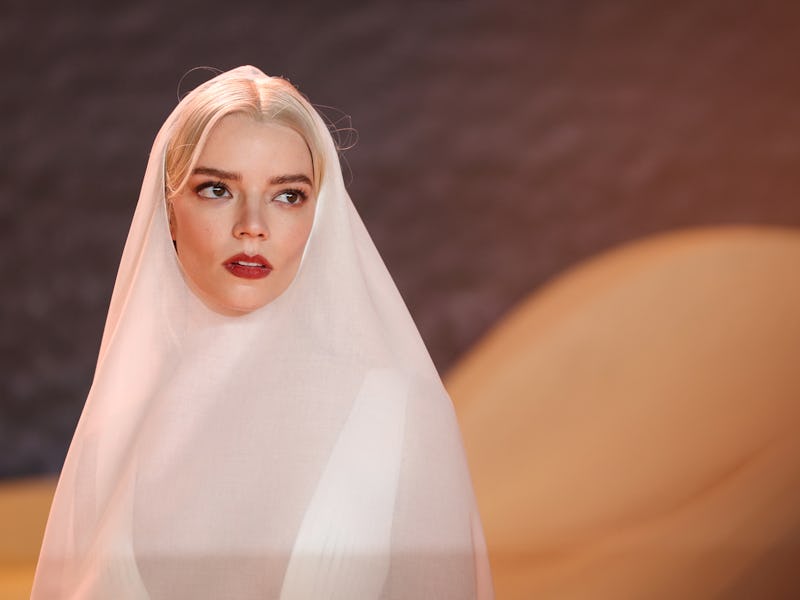Why Anya Taylor-Joy’s Cameo in Dune: Part Two is Such a Game-Changer
“Abomination!”

One week before Dune: Part Two hit theaters, Anya Taylor-Joy joined the cast at the premiere of the film in London. At that time, she confirmed that yes, she’s totally in the movie. Several fans guessed right away what role she was playing, and now that the movie is out, we can say... everyone was pretty much right.
And yet, the way Anya Taylor-Joy’s character is incorporated into Dune: Part Two is very surprising, mostly because it’s a big change from the novel. Here’s what to know about this surprising Dune: Part Two role, and how it might set up Dune 3.
Warning! Spoilers ahead for Dune: Part Two.
Who is Alia in Dune?
Rebecca Ferguson and Anya Taylor-Joy attending the premiere of Dune: Part Two.
In Dune: Part Two, Anya Taylor-Joy plays Alia Atreides, Paul’s sister and Jessica’s daughter. Although she is literally in the womb the entire movie and never speaks her own name, Taylor-Joy is playing Alia.
In the book, because Jessica ingests the Water of Life (sandworm bile!) as part of the ceremony to become the Reverend Mother of the Fremen, this causes Alia to be born with all the memories of her ancestors and emerge from the womb already talking and fully aware.
However, throughout the present of Dune: Part Two, Alia is in an embryonic state and isn’t born. So, unlike the book, the film ends with Jessica still pregnant even though she’s been chatting with the unborn Alia the whole time. We hear Taylor-Joy’s voice in the movie's final scenes as she says, “What is happening, mother?”
In another change from the book, the adult version of Alia is glimpsed by Paul in one of his prescient visions of the future, and it’s in this context that Taylor-Joy appears as Alia in Dune: Part Two, which foreshadows her pivotal influence in the subsequent two novels, Dune Messiah and Children of Dune. To be clear, although Taylor-Joy’s Alia does present a faithful-ish version of the character from those two novels, the idea that Paul has a future vision of his grown-up unborn sister is unique to Dune: Part Two and is not a thing that happens in the first Dune novel.
How Alia’s story changes Dune canon
Alia (Alicia Witt) in the 1984 Dune.
The fact that Alia is not born in the present of Dune: Part Two changes several plot details of the first novel. First, this decision significantly shortens the amount of time that passes in the second half of the novel. Instead of roughly two years of fighting against the Harkonnens and rallying the Fremen, Dune: Part Two has Paul’s ascendence happen in less than nine months. Indeed, as Irulan’s diary entries confirm, we’re still in 10,191, the same year as the first film.
In the novel, Alia is born as a super-powered baby, able to talk as a newborn because she possesses all the memories of her ancestors. In Dune: Part Two, we see the event that leads to this: Jessica takes the Water of Life in order to become the Fremen’s Reverend Mother, giving her all the collective memories of the Fremen. This action changes Alia in the womb, and sets her on a path to that leads Bene Gesserit in the second and third books to call her a “preborn abomination.”
By the third book, Children of Dune, Alia pulls a Kylo Ren, and colludes with the memory/spirit of her grandfather, Baron Harkonnen, to gain more power. Before that, in Dune Messiah, she falls in love with the Mentat clone of Duncan Idaho, initially known as “Hayt.”
But, for Anya Taylor-Joy’s Alia, all of that is in the future. For now, what Dune: Part Two doesn’t do is depict Alia as a walking, talking, wise-beyond-her-years murder baby. In the novel, it is baby Alia who slays the Baron, which is why in the future she’s known as “Alia of the Knife.” In the new film, Paul takes out the Baron, which is a huge change from the book, and arguably robs Alia of her most memorable moment from the original novel.
Both the 1984 and 2000 movie versions of Dune faithfully recreated this idea, with the child Alia being played by Alicia Witt and Laura Burton, respectively. Before Taylor-Joy, the only person to have played Alia as an adult is Daniela Amavia in 2003’s Children of Dune.
Will Alia be in Dune 3... or Dune 4?
Don’t mess with Alia, or her mother Lady Jessica.
We don’t yet know if Denis Villeneuve will make a third Dune film, but Taylor-Joy’s appearance in Dune: Part Two strongly suggests that the story could continue in at least one more movie. That said, if Villeneuve did create a third Dune movie based only on the events of Dune Messiah, he would, again, need to futz with the timeline. Just as Timothée Chalamet is a little older in the films than Paul is in the book, Alia would need to be older than a teenager to match up with the fact that Anya Taylor-Joy is clearly not a teenager.
So, the glimpse of the adult Alia in Dune: Part Two isn’t just tantalizing because it suggests the possibility of a film adaptation of Dune Messiah, the second book. Instead, because Anya Taylor-Joy is 27 years old in real life, she’s actually a closer match for Alia in Children of Dune, the third book. Villeneuve has been adamant that he’s only interested in making one more Dune film after Dune 2, and that the hypothetical movie would adapt the events of Messiah. And yet, by casting Anya Taylor-Joy in Dune 2, Villeneuve has already, at least partially, adapted the third novel, too.